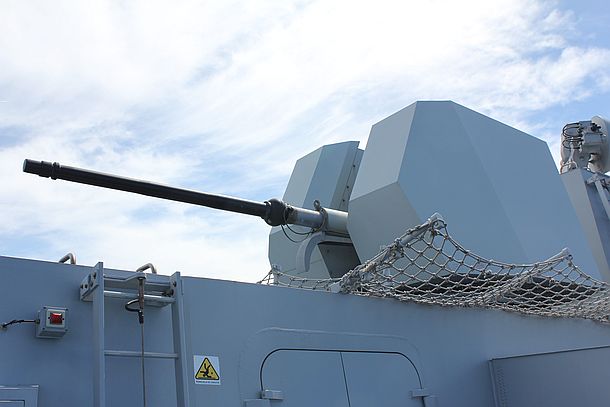Patrick Durrant | ITS Carabiniere
On Tuesday the Italian Militare Marina’s FREMM frigate Carabiniere departed Sydney for Melbourne on another leg of her busy Australian PR tour.
The Italian FREMM (Frigate European Multi-Mission) has of course been down selected for Australia’s future frigate program and her builder Fincantieri, along with Italian defence primes Leonardo, MBDA, and Telespazio Elettronica have been keen to show her off capabilities. ADM was fortunate to be invited aboard for the leg and was joined by a team from the Navy’s STRATFORCOM and also DST Group.
Having exited the heads following an aerial photo shoot within the surrounds of Sydney Harbour, the ship wasted no time bringing its gas turbine online and proceeding at speed towards Melbourne. With 24 knots rung on she proceeded comfortably at 27 knots thanks to the following East Australian Current. The ship has a CODLAG (COmbined Diesel Electric And Gas) propulsion configuration giving her a great deal of flexibility and engine efficiency.
“Our detection range is much greater than what I have been used to in the past.”
For the deployment, the vessel has embarked a single SH-90 helicopter though it is capable of embarking two aircraft including the larger EH-101.
Commandante Francesco Pagnotta, the ship's commanding officer, said the ships had been designed to stay at sea for extended periods outside of their usual operating area and their larger size certainly adds a greater level of comfort to the normal ships' company of 168 (in reality this is more like 140 when personnel leave is taken into account).
“The comfort and sustainability of the ship is much higher than what I have experienced in the past.”
Since being commissioned in April 2015, the ship has almost spent a year of that time at sea, with the current deployment expected to last until May (she departed La Spezia on 20th December), and a previous anti-piracy mission off Somalia lasting approximately six months.
After departing Melbourne on the 25th February the ship will participate in an exercise with the Royal Australian Navy off the West Australian coast before she proceeds to other destinations in South East Asia, including Jakarta and Langkawi. The exercise will include an LHD and six other units of the RAN and ADM understands ASW exercises will also be conducted in company with a Collins class submarine.
CMDTE Pagnotta was keen to demonstrate the ship's ASW capabilities during the exercise, acknowledging that the design had been down selected for Sea 5000 and the RAN's desire for an ASW capable frigate.
“Our detection range is much greater than what I have been used to in the past,” he said.
“With a bow mounted sonar and variable depth sonar it's quite normal to detect a submarine at around 40,000 yards (20 nm) and during an exercise with a German submarine using Air Independent Propulsion another FREMM (Carlo Margottini) detected the submarine at this range.”
The ship's ASW officer LT Fabio Scialpi said that previous detection ranges were more in the vicinity of around five nm.

Carabiniere's rear Oto Melara Super Rapido 76mm gun. The gun's high rate of fire and availability of specialised ammunition make it well-suited to varied roles such as short-range anti-missile point defence, anti-aircraft, anti-surface, and ground support. Credit: ADM (Patrick Durrant)
“But the ship also has great multi-role capabilities and we are looking forward to showing what we can do,” CMDTE Pagnotta said. “Even the ASW FREMMs are very capable in both the air defence and anti-surface roles for example,” he said.
The Chief Engineer LCDR Ugo Nieri said the engineering systems had performed well during the deployment, and his team was able to carry out a high degree of preventative maintenance while at sea. For maintenance tasks that required a greater level of sophistication, Pagnotta said they were able to rely on external support on the longer missions and two Isotta Fraschini engineers were embarked during the leg for planned diesel engine maintenance.
Regarding lessons learnt thus far in the deployment, CMDTE Pagnotta said the habitability of the FREMM had made a big difference. Also the redundancies built into the design made it a very easy platform to operate with fewer crew and the modern communications suite facilitated the ships' connection to support mechanisms back in Italy; it was even able to conduct remote training as if it were operating in formation with other naval units.
CMDTE Pagnotta said the ship had also outperformed expectations when it came to its own noise levels, being more silent than the design specifications. With regard to machinery space noise for instance, the actual in service levels were around 85 decibels compared to the 110 decibels as outlined in the specifications.
“From my point of view the ship outperforms the builders requirements, the diesels are housed so their noise is drastically reduced and they are also situated away from the hull,” Pagnotta said.
In ASW silent mode operations the ship runs on two diesel engines (out of a total of four) and the close proximity of the diesels to the shafts is another factor in delivering drastically reduced noise levels.
The twin rudders are also skewed at an angle, serving to stabilise the ship using dynamic control but also reducing the amount of cavitation.
LCDR Nieri also said there were redundancies that allowed quieter diesel fuel oil pumps to be used in silent mode and confirmed the maximum speed in that mode was 15.6 knots.
The warmer waters the ship had experienced both during this deployment, and the former African operations (up to 30 degrees) had not posed any problem, he said.
There will be more detail on the Italian FREMM and the Sea 5000 CEP in ADM's upcoming Seapower edition in April.



